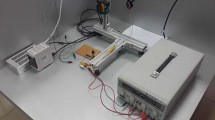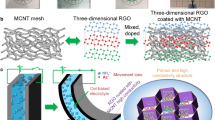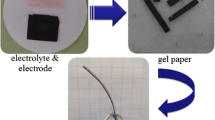Abstract
In this article, the effects of graphene loading (0.1, 0.2, 0.3 wt%) on both the electromechanical and mechanical properties of carboxymethylcellulose (CMC)-based actuators were investigated. CMC-based graphene-loaded actuators were prepared by using 1-butyl-3-methylimidazolium bromide. The synthesized graphene-loaded actuators were characterized by Fourier transform infrared, X-ray diffraction analysis, thermogravimetric analysis, scanning electron microscopy, and tensile tests. Electromechanical properties of the actuators were obtained under DC excitation voltages of 1, 3, 5, and 7 V with a laser displacement sensor. According to the obtained results, the ultimate tensile strength of CMC-based actuators containing 0.3 wt% graphene was higher than that of unloaded actuators by approximately 72.8 %. In addition, the Young’s modulus value of the graphene-loaded actuators increased continuously with increasing graphene content. Under a DC excitation voltage of 5 V, the maximum tip displacement of 0.2 wt% graphene-loaded actuators increased by about 15 % compared to unloaded actuators.






Similar content being viewed by others
References
Ahmad SR, Young RJ, Kinloch IA (2015) Raman spectra and mechanical properties of graphene/polypropylene nanocomposites. Int J Chem Eng Appl. doi:10.7763/IJCEA.2015.V6.440
Akar E, Altınışık A, Seki Y (2012) Preparation of pH-and ionic-strength responsive biodegradable fumaric acid crosslinked carboxymethyl cellulose. Carbohydr Polym 90:1634–1641
Akbari J, Heydari A (2012) Synthesis of Mn3O4 nanoparticles with controlled morphology using ionic liquid. Curr Nanosci 8:398–401
Baptista A, Ferreira I, Borges J (2013) Cellulose-based bioelectronic devices. In: van de Ven T, Godbout L (eds) Cellulose—medical, pharmaceutical and electronic applications. doi:10.5772/56721
Bar-Cohen Y (2012) Electroactive polymer (EAP) as actuators for biomimetic applications. In: Proceedings of the ASME international mechanical engineering congress and exposition (IMECE 2010) vol 9, pp 655–660
Bell SSJ, Geethanjali R, Subhashini S (2014) Synthesis and characterization of polyethylene glycol-g-Arginine and its corrosion—inhibition behaviour on mild steel. J Environ Nanotechnol 3:23–29
Biswal D, Singh R (2004) Characterisation of carboxymethyl cellulose and polyacrylamide graft copolymer. Carbohydr Polym 57:379–387
Cai Z, Kim J (2010) Bacterial cellulose/poly(ethylene glycol) composite: characterization and first evaluation of biocompatibility. Cellulose 17:83–91. doi:10.1007/s10570-009-9362-5
Cao Y, Wu J, Zhang J, Li HQ, Zhang Y, He JS (2009) Room temperature ionic liquids (RTILs): a new and versatile platform for cellulose processing and derivatization. Chem Eng J 147:13–21. doi:10.1016/j.cej.2008.11.011
Chai M, Isa M (2013) The oleic acid composition effect on the carboxymethyl cellulose based biopolymer electrolyte. J Crystal Process Technol 3:1
Edgar KJ, Buchanan CM, Debenham JS, Rundquist PA, Seiler BD, Shelton MC, Tindall D (2001) Advances in cellulose ester performance and application. Prog Polym Sci 26:1605–1688. doi:10.1016/S0079-6700(01)00027-2
El-Sayed S, Mahmoud KH, Fatah AA, Hassen A (2011) DSC, TGA and dielectric properties of carboxymethyl cellulose/polyvinyl alcohol blends. Phys B 406:4068–4076. doi:10.1016/j.physb.2011.07.050
Feng YY, Zhang XQ, Shen YT, Yoshino K, Feng W (2012) A mechanically strong, flexible and conductive film based on bacterial cellulose/graphene nanocomposite. Carbohydr Polym 87:644–649. doi:10.1016/j.carbpol.2011.08.039
Fischer S, Thummler K, Pfeiffer K, Liebert T, Heinze T (2002) Evaluation of molten inorganic salt hydrates as reaction medium for the derivatization of cellulose. Cellulose 9:293–300. doi:10.1023/A:1021121909508
Goswami D, Chattopadhyay A, Sharma A, Chattopadhyay S (2012) [bmim][Br] as a solvent and activator for the Ga-mediated barbier allylation: direct formation of an N-heterocyclic carbene from Ga metal. J Org Chem 77:11064–11070. doi:10.1021/Jo3020775
Habibi N (2014) Preparation of biocompatible magnetite-carboxymethyl cellulose nanocomposite: characterization of nanocomposite by FTIR, XRD, FESEM and TEM. Spectrochim Acta Part A Mol Biomol Spectrosc 131:55–58
Haldorai Y, Shim JJ (2014) Chemo-responsive bilayer actuator film: fabrication, characterization and actuator response. New J Chem 38:2653–2659. doi:10.1039/C4nj00014e
Hua L et al (2014) Immobilization of polyoxometalate-based ionic liquid on carboxymethyl cellulose for epoxidation of olefins. New J Chem 38:3953–3959. doi:10.1039/C4nj00270a
Huang Y, Liang JJ, Chen YS (2012) The application of graphene based materials for actuators. J Mater Chem 22:3671–3679. doi:10.1039/C2jm15536b
Jung JH, Jeon JH, Sridhar V, Oh IK (2011) Electro-active graphene–Nafion actuators. Carbon 49:1279–1289. doi:10.1016/j.carbon.2010.11.047
Kikuchi K, Tsuchitani S (2009) Nafion®-based polymer actuators with ionic liquids as solvent incorporated at room temperature. J Appl Phys. doi:10.1063/1.3204961
Kim J, Yun S, Ounaies Z (2006) Discovery of cellulose as a smart material. Macromolecules 39:4202–4206. doi:10.1021/Ma060261e
Kim KB, Kim J (2013) Fabrication and characterization of electro-active cellulose films regenerated by using 1-butyl-3-methylimidazolium chloride ionic liquid. Proc Inst Mech Eng C 227:2665–2670. doi:10.1177/0954406213478707
Lee C, Wei XD, Kysar JW, Hone J (2008) Measurement of the elastic properties and intrinsic strength of monolayer graphene. Science 321:385–388. doi:10.1126/science.1157996
Murphy EB, Wudl F (2010) The world of smart healable materials. Prog Polym Sci 35:223–251. doi:10.1016/j.progpolymsci.2009.10.006
Muzart J (2006) Ionic liquids as solvents for catalyzed oxidations of organic compounds. Adv Synth Catal 348:275–295. doi:10.1002/adsc.200505273
Nieto A, Lahiri D, Agarwal A (2012) Synthesis and properties of bulk graphene nanoplatelets consolidated by spark plasma sintering. Carbon 50:4068–4077. doi:10.1016/j.carbon.2012.04.054
Novoselov KS et al (2004) Electric field effect in atomically thin carbon films. Science 306:666–669. doi:10.1126/science.1102896
Ozdemir O, Karakuzu R, Sarikanat M, Akar E, Seki Y, Cetin L, Sen I, Gurses BO, Yılmaz OC, Sever K, Mermer O (2015) Effects of PEG loading on electromechanical behavior of cellulose-based electroactive composite. Cellulose. doi:10.1007/s10570-015-0581-7
Pang JH, Liu X, Zhang XM, Wu YY, Sun RC (2013) Fabrication of cellulose film with enhanced mechanical properties in ionic liquid 1-allyl-3-methylimidaxolium chloride (AmimCl). Materials 6:1270–1284. doi:10.3390/Ma6041270
Patil ML, Sasai H (2008) Recent developments on chiral ionic liquids: design, synthesis, and applications. Chem Rec 8:98–108. doi:10.1002/Tcr.20143
Polu AR, Kumar R (2011) Impedance spectroscopy and FTIR studies of PEG—based polymer electrolytes. J Chem 8:347–353
Polu AR, Kumar R, Causin V, Neppalli R (2011) Conductivity, XRD, and FTIR studies of new Mg2+-ion-conducting solid polymer electrolytes: [PEG: Mg(CH3COO)(2)]. J Korean Phys Soc 59:114–118. doi:10.3938/Jkps.59.114
Qiu XY, Hu SW (2013) “Smart” materials based on cellulose: a review of the preparations, properties, and applications. Materials 6:738–781. doi:10.3390/Ma6030738
Rajkumar T, Ranga Rao G (2008) Characterization of hybrid molecular material prepared by 1-butyl 3-methyl imidazolium bromide and phosphotungstic acid. Mater Lett 62:4134–4136
Ranga Rao G, Rajkumar T, Varghese B (2009) Synthesis and characterization of 1-butyl 3-methyl imidazolium phosphomolybdate molecular salt. Solid State Sci 11:36–42
Ravikiran Y, Kotresh S, Vijayakumari S, Thomas S (2014) Liquid petroleum gas sensing performance of polyaniline-carboxymethyl cellulose composite at room temperature. Curr Appl Phys 14(7):960–964
Sen I et al (2015) Electroactive behavior of graphene nanoplatelets loaded cellulose composite actuators. Compos Part B Eng 69:369–377. doi:10.1016/j.compositesb.2014.10.016
Shahinpoor M, Bar-Cohen Y, Simpson JO, Smith J (1998) Ionic polymer-metal composites (IPMCs) as biomimetic sensors, actuators and artificial muscles—a review. Smart Mater Struct 7:R15–R30. doi:10.1088/0964-1726/7/6/001
Shahinpoor M, Kim KJ (2001) Ionic polymer-metal composites: I. Fundamentals. Smart Mater Struct 10:819–833. doi:10.1088/0964-1726/10/4/327
Shang J, Shao ZZ, Chen X (2008) Electrical behavior of a natural polyelectrolyte hydrogel: chitosan/carboxymethylcellulose hydrogel. Biomacromolecules 9:1208–1213. doi:10.1021/Bm701204j
Swatloski RP, Spear SK, Holbrey JD, Rogers RD (2002) Dissolution of cellose with ionic liquids. J Am Chem Soc 124:4974–4975. doi:10.1021/Ja025790m
Wojtoniszak M et al (2012) Synthesis, dispersion, and cytocompatibility of graphene oxide and reduced graphene oxide. Colloids Surf B 89:79–85
Xia JL, Chen F, Li JH, Tao NJ (2009) Measurement of the quantum capacitance of graphene. Nat Nanotechnol 4:505–509. doi:10.1038/Nnano.2009.177
Yang X, He L, Qin S, Tao GH, Huang M, Lv Y (2014) Electrochemical and thermodynamic properties of Ln(III) (Ln = Eu, Sm, Dy, Nd) in 1-butyl-3-methylimidazolium bromide ionic liquid. Plos One. doi:10.1371/journal.pone.0095832
Zare A et al (2011) Ionic liquid 1-butyl-3-methylimidazolium bromide ([Bmim]Br) as a green and neutral reaction media for the catalyst-free synthesis of 1-amidoalkyl-2-naphthols. Sci Iran 18:433–438. doi:10.1016/j.scient.2011.05.005
Zhao Y, Song L, Zhang ZP, Qu LT (2013) Stimulus-responsive graphene systems towards actuator applications. Energy Environ Sci 6:3520–3536. doi:10.1039/C3ee42812e
Acknowledgments
This study was supported by TUBITAK—The Scientific and Technological Research Council of Turkey, project no. 111M643.
Author information
Authors and Affiliations
Corresponding author
Rights and permissions
About this article
Cite this article
Ozdemir, O., Karakuzu, R., Sarikanat, M. et al. Improvement of the electromechanical performance of carboxymethylcellulose-based actuators by graphene nanoplatelet loading. Cellulose 22, 3251–3260 (2015). https://doi.org/10.1007/s10570-015-0702-3
Received:
Accepted:
Published:
Issue Date:
DOI: https://doi.org/10.1007/s10570-015-0702-3




